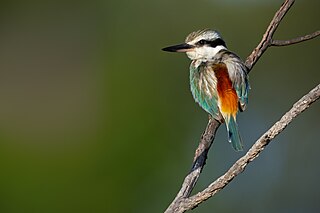
The common kingfisher, also known as the Eurasian kingfisher and river kingfisher, is a small kingfisher with seven subspecies recognized within its wide distribution across Eurasia and North Africa. It is resident in much of its range, but migrates from areas where rivers freeze in winter.

The Oriental dollarbird is a bird of the roller family, so named because of the distinctive pale blue or white, coin-shaped spots on its wings. It can be found from Australia to Korea, Japan and India.

The rainbow bee-eater is a near passerine bird in the bee-eater family Meropidae.

The azure kingfisher is a small kingfisher in the river kingfisher subfamily, Alcedininae.

The king bird-of-paradise is a passerine bird of the Paradisaeidae (bird-of-paradise) family. It is considered by the IOC checklist to be the only member of the genus Cicinnurus, although the genus Diphyllodes is closely related and is subsumed under Cicinnurus by many other authorities.

The buff-breasted paradise kingfisher is a bird in the tree kingfisher subfamily, Halcyoninae. It is native to Australia and New Guinea. It migrates in November from New Guinea to its breeding grounds in the rainforest of North Queensland, Australia. Like all paradise kingfishers, this bird has colourful plumage with a red bill, buff breast and distinctive long tail streamers.

Wallace's fruit dove is a species of a bird in the pigeon family Columbidae. The name commemorates the British naturalist Alfred Russel Wallace. It is a rather large, long-tailed fruit dove with a length of 24–28 cm (9.4–11.0 in) and has been described as "one of the most beautiful" fruit doves. The forehead and crown are dull crimson, the lower face and throat are white, and the rest of the head, breast, neck, and upper back are pale bluish-grey. The wings and lower back are green and the belly is orange, separated from the chest by a white band. Both sexes look similar, but females have less extensive red on the head and a greenish tinge to their grey parts.

The shovel-billed kookaburra, also known as the shovel-billed kingfisher, is a large, approximately 33 cm (13 in) long, dark brown tree kingfisher with a heavy, short, and broad bill that is unique among the kingfishers. It has a dark head with a rufous stripe behind the eyes, a white throat, a rufous neck collar and underparts, a bright blue rump, brown iris, brownish-black bill with paler mandible, and pale feet. Both sexes are similar in appearance, but are easily recognized from the colour of the tail. The male has a dark bluish tail while female's is rufous. The juvenile has a female-like plumage with scale-patterned feathers.

The collared kingfisher is a medium-sized kingfisher belonging to the subfamily Halcyoninae, the tree kingfishers. It is also known as the white-collared kingfisher, black-masked kingfisher or mangrove kingfisher. It has a wide range extending from the Red Sea across southern Asia to Polynesia. A number of subspecies and subspecies groups have been split from this species including the Pacific kingfisher, the islet kingfisher, the Torresian kingfisher, the Mariana kingfisher, and the Melanesian kingfisher.

The blue-fronted fig parrot is a species of parrot in the family Psittaculidae. It is found in Salawati and the Bird's Head Peninsula in New Guinea. Its natural habitat is subtropical or tropical moist lowland forests.

The moustached kingfisher, also called Bougainville moustached kingfisher, is a species of bird in the family Alcedinidae. It is endemic to Bougainville Island in Papua New Guinea. An estimated 250–1,000 mature individuals are left.

The little kingfisher is a species of kingfisher in the subfamily Alcedininae.

The mountain kingfisher is a species of bird in the subfamily Halcyoninae in the family Alcedinidae. Adult males are 21–24 cm (8.3–9.4 in) long, and have a rufous head and underparts, greenish-blue upperparts, a dark blue tail, and black flight feathers. They also have dark neck patches and loral patches. Females have dark crowns and the neck patches join at the nape. It is similar to the yellow-billed kingfisher, but can be distinguished by its larger size and a proportionally larger bill, along with a dark ridge along its culmen.

The forest kingfisher, also known as Macleay's or the blue kingfisher, is a species of kingfisher in the subfamily Halcyoninae, also known as tree kingfishers. It is a predominantly blue and white bird. It is found in Indonesia, New Guinea and coastal eastern and Northern Australia. Like many other kingfishers, it hunts invertebrates, small frogs, and lizards.

The red-backed kingfisher is a species of kingfisher in the subfamily Halcyoninae, also known as tree kingfishers. It is a predominantly blue-green and white bird with a chestnut rump. It is found across the continent of Australia, mainly inhabiting the drier regions.

The yellow-breasted boatbill is a species of bird found in New Guinea and Far North Queensland, Australia. The yellow-breasted boatbill is a species of bird belonging to the Machaerirhynchidae family, of the genus Machaerirhynchus. The yellow-breasted boatbill is a common avian animal, and it is well known within communities of ornithologists. Its natural habitat is primarily that of subtropical or tropical regions, particularly moist forests; the yellow-breasted boatbill has no preference for altitude within its environment and can be found abundantly in its natural habitat.

The shining flycatcher is a species of bird in the family Monarchidae. It is found in northern Australia, and from the Moluccas to the Bismarck Archipelago. Its natural habitats are subtropical or tropical moist lowland forest and subtropical or tropical mangrove forest.

The goldenface is a species of passerine bird endemic to New Guinea. It is the only species (monotypic) within the genus Pachycare.




















